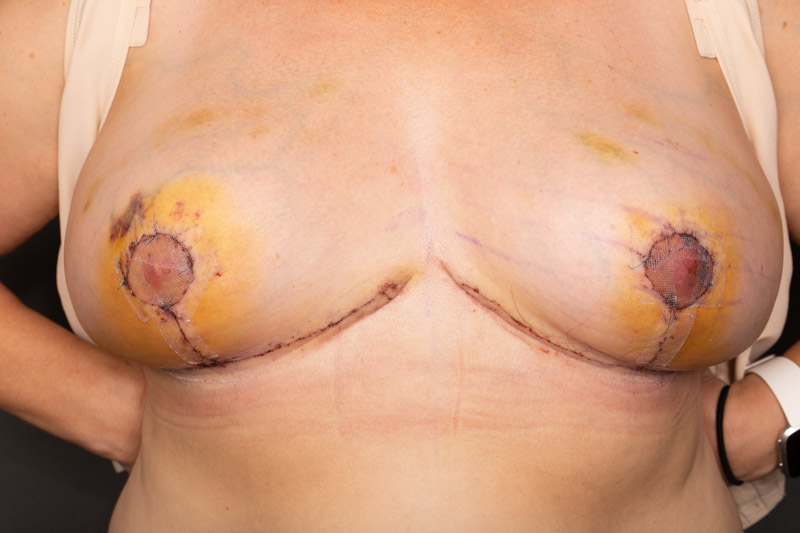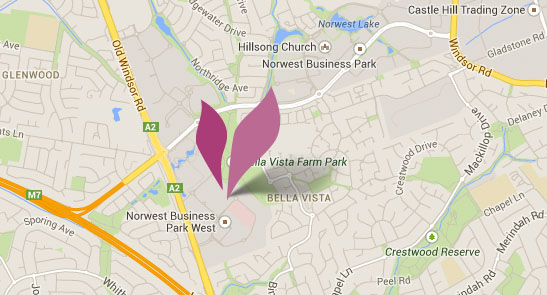Dr Gavin Sandercoe
What is nipple necrosis?
Necrosis is the medical term for tissue death. Nipple necrosis is death of a nipple. When a nipple is moved during a breast lift or breast reduction, there is about a 1% chance that the nipple will not survive the move/operation. All Specialist Plastic Surgeons will encounter nipples with altered blood supply occasionally. It is a game of numbers – anyone that has performed 1000 breast reductions or breast lifts will have seen it if they follow their patients closely.
How does nipple necrosis happen?
All tissues rely on blood coming in and out of them to deliver oxygen & nutrients and remove wastes. Arteries bring blood in, veins take blood out. If there is not enough blood coming in, the tissues do not have enough supplies of oxygen and nutrients. This situation is called ischaemia. The opposite situation, not enough blood going out, is termed congestion. Either of these two mechanisms can cause a nipple, or the breast tissue beneath it, to die after an operation.

How do Specialist Plastic Surgeons prevent nipple necrosis?
When moving a nipple during a breast reduction or breast lift, Specialist Plastic Surgeons use a segment of tissue with a blood supply to rotate the nipple into the desired position. This segment of tissue is usually designed around a known pattern of blood vessels and is termed a pedicle. There are multiple major sources of blood supply to the breast & nipple and they interconnect as a network within the breast gland. Specialist Plastic Surgeons utilise a knowledge of the blood supply of the breast to design your breast reduction to best suit the needs of your requested breast volume and shape.
Do all blood supplies (pedicles) always work?
No. There are about 6 well described sources of blood supply for the nipple, and a few others that are less well described or uncommonly used in Australia. Each pedicle (or main direction of blood flow) has advantages and disadvantages. Not all blood vessels are present in every breast. In choosing a pedicle, your Specialist Plastic Surgeon needs to divide (cut) other blood vessels to move that segment of breast gland and nipple. Occasionally the choice of pedicle requires the division of the major blood supply to the nipple. This is not predictable pre-operatively and may not be obvious during the operation.
What happens if the operation results in an abnormal blood supply to a nipple?
Sometimes during a breast reduction or breast lift, your Specialist Plastic Surgeon might notice that one (rarely both) nipple is struggling with the blood supply that is remaining after they dissect out the pedicle that they have chosen to move your nipple and reshape your breast. A nipple that has not enough blood going into it might turn pale, whereas a nipple that is struggling to get blood back out of it will turn purple. These colour changes are easier to notice in pale areolas, and harder to observe in very dark areolas.
There are strategies that your Specialist Plastic Surgeon can employ to help correct an abnormal blood supply to a pedicle/nipple. The first step that most surgeons take is to check the pedicle and nipple orientation or inset. A pedicle that is inset too tightly or has a tight turn can be re-arranged to prevent kinking and allow better blood flow.
If this fails to re-establish a normal colour to the nipple and areola, the next step is to remove some of the volume of the pedicle so that the blood flow in and out of that segment of breast tissue and nipple is rebalanced to allow better flow to the critical tissues. This naturally results in a smaller breast on that side and increases the risk of nipple numbness after the operation.
Finally, if this strategy does not work, the remaining step is for your Specialist Plastic Surgeon to perform a free nipple graft. In this situation, the nipple is completely detached from the underlying breast gland/tissue and placed on the remaining breast mound as a graft. It is Dr Sandercoe’s preference to remove any breast tissue from the pedicle that does not demonstrate a robust blood supply at this point. Again, this will result in a smaller breast than initially planned. Depending on the point of your procedure that this happens, the chances of nipple survival can vary.

Why not perform free nipple grafts all the time?
Free nipple grafting was a standard procedure in the early days of breast reductions, prior to the detailed understanding of blood supply of the breast gland that all Specialist Plastic Surgeons know today. There are circumstances that your Specialist Plastic Surgeon may recommend free nipple grafting such as very long distances in the pedicles that they commonly use. Grafted nipples lose some of their pigment/colour, a fair bit of their projection, and almost always lose sensitivity. Grafted nipples might feel pressure due to the nerves and sensors in the underlying breast gland, but almost never feel light touch. Grafted nipples also have a reputation for more asymmetry between sides than nipples preserved on pedicles.
Patient Education Library




